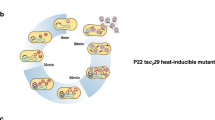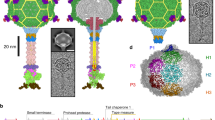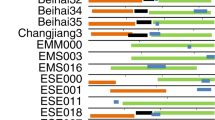Abstract
The G region of bacteriophage Mu is a 3,000-base pair (bp) invertible DNA segment that determines the host specificity of the phage1,2. Only phage with the G segment in the orientation designated (+) can adsorb to Escherichia coli K-12 (refs 3–5), whereas phage with the G segment in the (−) orientation infects other hosts such as Citrobacter freundii and E. coli C (ref. 1). It has been proposed that four genes are involved in host specificity—S, U, S′ and U′—of which S and U are expressed in the orientation (+) and S′ and U′ in the inverted orientation (−) of the G segment. We have presented two alternatives for the organization of these genes (Fig. 1). In model A the four genes involved are entirely contained within the G segment, whereas in the alternative model (B) it is assumed that the proximal part of the S gene is located in the a part of the Mu genome. We report here that the S and S′ genes are partially located outside the G segment and share a common part located in α (Sc). This common S region will be joined by G inversion to one of the two variable parts (Sv or Sv′) which results in the synthesis of either tail fibre protein S or S′.
This is a preview of subscription content, access via your institution
Access options
Subscribe to this journal
Receive 51 print issues and online access
$199.00 per year
only $3.90 per issue
Buy this article
- Purchase on Springer Link
- Instant access to full article PDF
Prices may be subject to local taxes which are calculated during checkout
Similar content being viewed by others
References
Van de Putte, P., Cramer, S. & Giphart-Gassler, M. Nature 286, 218–222 (1980).
Howe, M. M. Cell 21, 605–606 (1980).
Symonds, N. & Coelho, A. Nature 271, 573–574 (1978).
Bukhari, A. I. & Ambrosio, L. Nature 271, 575–577 (1978).
Kamp, D., Kahmann, R., Zipser, D., Broker, T. R. & Chow, L. T. Nature 271, 577–580 (1978).
Chow, L. T., Kahmann, R. & Kamp, D. J. molec. Biol. 113, 591–609 (1977).
Auerswald, E. A., Ludwig, G. & Schaller, H. Cold Spring Harb. Symp. quant. Biol. 45, 107–113 (1981).
Rothstein, S. J., Jorgensen, R. A., Postle, K. & Reznikoff, W. S. Cell 19, 795–805 (1980).
Kwoh, D. Y. & Zipser, D. Virology 114, 291–296 (1981).
Sakano, H., Maki, R., Kurosawa, Y., Roeder, W. & Tonegawa, S. Nature 286, 676–683 (1980).
Davis, M. M. et al. Nature 283, 733–739 (1980).
Howe, M. M., Schumm, J. W. & Taylor, A. L. Virology 92, 108–124 (1979).
Giphart-Gassler, M., Wijffelman, C. & Reeve, J. J. molec. Biol. 145, 139–163 (1981).
Schumann, W. & Bade, E. G. Molec. gen. Genet. 169, 97–105 (1979).
Jorgensen, R. A., Rothstein, S. & Reznikoff, W. S. Molec. gen. Genet. 177, 65–72 (1979).
O'Day, K., Schultz, D., Ericsen, W., Rawluk, L. & Howe, M. M. Virology 93, 320–328 (1979).
Sancar, A., Williams, K. R., Chase, J. W. & Rupp, W. D. Proc. natn. Acad. Sci. U.S.A. 78, 4274–4278 (1981).
Author information
Authors and Affiliations
Rights and permissions
About this article
Cite this article
Giphart-Gassler, M., Plasterk, R. & van de Putte, P. G inversion in bacteriophage Mu: a novel way of gene splicing. Nature 297, 339–342 (1982). https://doi.org/10.1038/297339a0
Received:
Accepted:
Issue Date:
DOI: https://doi.org/10.1038/297339a0
This article is cited by
-
Use of Synchronous Site-Specific Recombination in Vivo to Regulate Gene Expression
Bio/Technology (1984)
-
Transcription initiation of Mu mom depends on methylation of the promoter region and a phage-coded transactivator
Nature (1983)
-
Genome fusion mediated by the site specific DNA inversion system of bacteriophage P1
Molecular and General Genetics MGG (1983)
-
The cloning and characterization of the glnF (ntrA) gene of Klebsiella pneumoniae: Role of glnF (ntrA) in the regulation of nitrogen fixation (nif) and other nitrogen assimilation genes
Molecular and General Genetics MGG (1983)
Comments
By submitting a comment you agree to abide by our Terms and Community Guidelines. If you find something abusive or that does not comply with our terms or guidelines please flag it as inappropriate.



